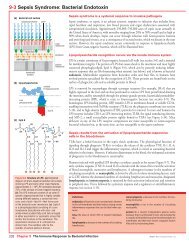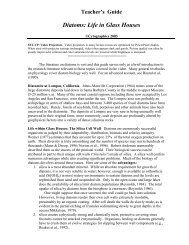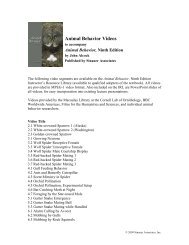The Human Eye: Structure and Function - Sinauer Associates
The Human Eye: Structure and Function - Sinauer Associates
The Human Eye: Structure and Function - Sinauer Associates
You also want an ePaper? Increase the reach of your titles
YUMPU automatically turns print PDFs into web optimized ePapers that Google loves.
ContentsPreface xxiiiAcknowledgments xxviiiPrologue A Brief History of <strong>Eye</strong>s 1<strong>The</strong> Antiquity of <strong>Eye</strong>s <strong>and</strong> Vision 1Thinking about the eye gave Charles Darwin “a cold shudder” 1<strong>The</strong> history of the eye is embedded in the history of animals <strong>and</strong>molecules 2Several of the eye’s critical molecules are ancient 3<strong>Eye</strong>s were invented by multicellular animals almost 600 million yearsago 5<strong>Eye</strong>s arose not once, but numerous times, in different animal groups 6<strong>Eye</strong>s are most common in groups of motile animals living in lightedenvironments 8<strong>The</strong> Diversity <strong>and</strong> Distribution of <strong>Eye</strong>s 9<strong>The</strong> first step in vision is an eye that can sense the direction of incidentlight 9At least ten types of eyes can be distinguished by differences in theiroptical systems 11Vertebrates always have simple eyes, but invertebrates can havecompound eyes, simple eyes, or both 13Paths <strong>and</strong> Obstacles to Perfection 16Simple eyes improve as they become larger 16Elaborate simple eyes may have evolved rapidly 18Compound eyes have inherent optical limitations in theirperformance 19An Ocular Bestiary: Fourteen <strong>Eye</strong>s <strong>and</strong> <strong>The</strong>ir Animals 21I. Compound eye—focal apposition, terrestrial variety: Honeybee(Apis mellifica) 21II. Compound eye—focal apposition, aquatic variety: Horseshoe crab(Limulus polyphemus) 23III. Compound eye—afocal apposition: Monarch butterfly (Danausplexippus) 26© <strong>Sinauer</strong> <strong>Associates</strong>, Inc. This material cannot be copied, reproduced, manufacturedor disseminated in any form without express written permission from the publisher.ix
ContentsxiiiBOX 4.2 Changing the Effects of Extraocular MuscleContraction 152VIGNETTE 4.1 Locating the Extraocular Muscles 164VIGNETTE 4.2 In the Service of the <strong>Eye</strong> 184Chapter 5 <strong>The</strong> Nerves of the <strong>Eye</strong> <strong>and</strong>Orbit 191Elements of Neural Organization 191<strong>The</strong> brain deals with information about the externalworld <strong>and</strong> the body 191Neurons are the anatomical elements of neuralsystems 191Neural circuits consist of neurons linked mostly byunidirectional chemical synapses 193<strong>The</strong> direction of neural information flow distinguishesbetween sensory <strong>and</strong> motor nerves 194Motor outputs are divided anatomically <strong>and</strong> functionallyinto somatic <strong>and</strong> autonomic systems 194<strong>The</strong> autonomic system is subdivided into thesympathetic <strong>and</strong> parasympathetic systems 194<strong>The</strong> Optic Nerve <strong>and</strong> the Flow of Visual Information 195In the optic nerve, the location of axons from retinalganglion cells corresponds to their location on theretina 195Axons from the two optic nerves are redistributed in theoptic chiasm 198<strong>The</strong> decussation of axons in the chiasm is imperfect 199Spatial ordering of axons changes in the optic tracts 200In the lateral geniculate nuclei, which are primary targetsof axons in the optic tracts, inputs from the two eyes areseparated into different layers 200Axons terminating in the lateral geniculate nuclei arespatially ordered 201Some axons leave the optic tracts for otherdestinations 203Axons terminating in the superior colliculi formdiscontinuous retinotopic maps 204Axons forming the afferent part of the pupillary lightreflex pathway terminate in the pretectal nuclearcomplex 204Retinal inputs to the accessory optic system may helpcoordinate eye <strong>and</strong> head movement 205Retinal axons may provide inputs to a biologicalclock 205Lesions of the optic nerves <strong>and</strong> tracts produce defects inthe visual fields 207Lesions in the secondary visual pathways can beobserved only as motor deficits 212<strong>The</strong> Trigeminal Nerve: Signals for Touch <strong>and</strong> Pain 212Two of the three trigeminal divisions carry signals fromthe eye <strong>and</strong> surrounding tissues 212All somatosensory information from the eye is conveyedby the nasociliary nerve to the ophthalmic division ofthe trigeminal 213Sensory nerve fibers from the cornea, conjunctiva,limbus, <strong>and</strong> anterior sclera join to form the long ciliarynerves 213Stimulation of corneal or conjunctival nerve endingselicits sensations of touch or pain, a blink reflex, <strong>and</strong>reflex lacrimation 215Other sensory fibers from the eye are conveyed by theshort ciliary nerves <strong>and</strong> the sensory root of the ciliaryganglion 215Most other branches of the ophthalmic nerve carrysomatosensory fibers from the skin of the eyelids <strong>and</strong>face 215A few branches of the maxillary nerve pass through theorbit from the facial skin <strong>and</strong> the maxillary sinus 217Lesions in the branching hierarchy of the ophthalmicnerve produce anesthesia that helps identify the lesionsite 218Viral infection of the trigeminal system can producesevere corneal damage 219<strong>The</strong> Extraocular Motor Nerves 219<strong>The</strong> three cranial nerves that innervate the extraocularmuscles contain axons from clusters of cells in thebrainstem 219Cells in different parts of the oculomotor nerve nucleusinnervate the levator, the superior <strong>and</strong> inferior recti, themedial rectus, <strong>and</strong> the inferior oblique 219Axons destined for different muscles run together in theoculomotor nerve until it exits the cavernous sinus justbehind the orbit 221<strong>The</strong> oculomotor nerve contains parasympathetic fibersbound for the ciliary ganglion 224Cells in the trochlear nerve nucleus innervate thecontralateral superior oblique 224Abducens nerve cells innervate the ipsilateral lateralrectus 225All of the oculomotor nerves pass through the cavernoussinus on their way to the orbit 225<strong>The</strong> extraocular motor nerves probably contain sensoryaxons from muscle spindles <strong>and</strong> tendon organs 226Innervation of the Muscles of the <strong>Eye</strong>lids 226Three sets of muscles are associated with the eyelids 226<strong>The</strong> orbicularis is innervated by the facial nerve 227<strong>The</strong> superior <strong>and</strong> inferior tarsal muscles are innervatedby the sympathetic system 227Ptosis may result from either oculomotor or sympatheticlesions 228Autonomic Innervation of Smooth Muscle withinthe <strong>Eye</strong> 228<strong>The</strong> superior cervical ganglion is the source of mostsympathetic innervation to the eye 228© <strong>Sinauer</strong> <strong>Associates</strong>, Inc. This material cannot be copied, reproduced, manufacturedor disseminated in any form without express written permission from the publisher.
xivContentsSympathetic fibers enter the eye in the short ciliarynerves 230Sympathetic innervation of the dilator muscle acts atalpha-adrenergic receptors to dilate the pupils 230<strong>The</strong> arterioles in the uveal tract receive sympatheticinnervation that produces vasoconstriction 231Horner’s syndrome is the result of a central lesion in thesympathetic pathway 231Parasympathetic fibers entering the eye originate in theciliary or the pterygopalatine ganglion 231Axons from cells in the ciliary ganglion innervate thesphincter <strong>and</strong> the ciliary muscle 232Axons from the pterygopalatine ganglion cells innervatevascular smooth muscle in the choroid 233Accommodation <strong>and</strong> pupillary light reflexes shareefferent pathways from the Edinger–Westphal nuclei tothe eyes; pupillary reflexes are mediated by retinalsignals reaching the Edinger–Westphal nuclei throughthe pretectal complex 233Deficient pupillary reflexes may be associated withmidbrain lesions 234Innervation of the Lacrimal Gl<strong>and</strong> 235Axons from cells in the pterygopalatine ganglion reachthe lacrimal gl<strong>and</strong> via the zygomatic <strong>and</strong> lacrimalnerves 235<strong>The</strong> efferent pathway for lacrimal innervation begins inthe facial nerve nucleus 235Basal tear production may require tonic innervation ofthe lacrimal gl<strong>and</strong> 236Some Issues in Neural Development 236Specialized growth cones guide the extension of axons<strong>and</strong> dendrites 236Pathfinding by growth cones depends on recognition oflocal direction signs 237Target recognition <strong>and</strong> acquisition may require specificmarkers produced by the target cells 238Many early neurons are eliminated as mature patterns ofconnectivity are established 238Adult connectivity patterns are not always complete atbirth, <strong>and</strong> postnatal development is subject tomodification 239Ocular albinism is associated with a pathfinding error inthe development of optic nerve axons 239Anomalous innervation of the extraocular musclesmay be the result of pathfinding or target recognitionerrors 240Some forms of amblyopia may be related to problemswith postnatal establishment <strong>and</strong> maintenance ofsynaptic connections 240Innervation of the extraocular muscles begins early ingestation, sensory innervation much later 241Postnatal Neuron Growth <strong>and</strong> Regeneration 241Most postnatal neuron growth is interstitial growth 241Neurons do not undergo mitosis postnatally 242Spinal neurons in peripheral nerves can regenerate afterbeing damaged 242Central nervous system neurons do not regeneratefollowing major damage 242Corneal nerve endings will regenerate following localdamage 243Neuronal degeneration can affect other, undamaged neurons243VIGNETTE 5.1 <strong>The</strong> Integrative Action of the NervousSystem 196BOX 5.1 Tracing Neural Pathways: Degeneration <strong>and</strong>Myelin Staining 206VIGNETTE 5.2 Seeing One World with Two <strong>Eye</strong>s:<strong>The</strong> Problem of Decussation 210BOX 5.2 Tracing Neuronal Connections: AxonalTransport Methods 222Chapter 6 Blood Supply <strong>and</strong> Drainage 247Distributing Blood to Tissues 247Arteries control blood flow through capillary beds, <strong>and</strong>veins regulate blood volume 247Blood flow through capillary beds can be controlledlocally or systemically 248Capillary beds in a tissue may be independent orinterconnected 251<strong>The</strong> interchange between blood <strong>and</strong> cells depends partlyon the structure of the vascular endothelium 252Capillary endothelium is renewable, <strong>and</strong> capillary bedscan change 253Neovascularization is a response to altered functionaldem<strong>and</strong>s 253Structurally weakened capillaries may be prone toexcessive neovascularization 254<strong>The</strong> Ophthalmic Artery <strong>and</strong> Ophthalmic Veins 255<strong>The</strong> ophthalmic artery distributes blood to the eye <strong>and</strong> itssurroundings 255Blood supplied to tissues by the ophthalmic artery isdrained to the cavernous sinus by the ophthalmicveins 257Supply <strong>and</strong> Drainage of the <strong>Eye</strong> 260Muscular arteries supply both the extraocular muscles<strong>and</strong> the anterior segment of the eye 260<strong>The</strong> anterior ciliary arteries contribute to the episcleral<strong>and</strong> intramuscular arterial circles 261<strong>The</strong> conjunctiva <strong>and</strong> corneal arcades are supplied bybranches from the episcleral arterial circle <strong>and</strong> drainedby the episcleral <strong>and</strong> anterior ciliary veins 262<strong>The</strong> system of episcleral veins drains the conjunctiva,corneal arcades, <strong>and</strong> limbus 263© <strong>Sinauer</strong> <strong>Associates</strong>, Inc. This material cannot be copied, reproduced, manufacturedor disseminated in any form without express written permission from the publisher.
Contentsxv<strong>The</strong> posterior ciliary arteries divide into long <strong>and</strong> shortposterior ciliary arteries that supply differentregions 264<strong>The</strong> intramuscular <strong>and</strong> major arterial circles are formedin the ciliary body by branches from the anterior <strong>and</strong>long posterior ciliary arteries 265Blood supply to the anterior segment is redundant, butthere is some segmentation in supply to the iris 268<strong>The</strong> short posterior ciliary arteries terminate in thechoriocapillaris, which supplies the retinalphotoreceptors 269<strong>The</strong> short posterior ciliary arteries contribute to thesupply of the optic nerve through the circle of Zinn 272<strong>The</strong> short posterior ciliary arteries sometimes contributeto the supply of the inner retina 274<strong>The</strong> central retinal artery enters the eye through the opticnerve <strong>and</strong> ramifies to supply the inner retina 275<strong>The</strong> central retinal vein exits the eye through the opticnerve 277<strong>The</strong> vortex veins drain most of the uveal tract 277<strong>The</strong> vortex veins have segmented drainage fields, butthey are heavily anastomotic 278Supply <strong>and</strong> Drainage of the <strong>Eye</strong>lids <strong>and</strong> SurroundingTissues 279<strong>The</strong> lacrimal gl<strong>and</strong> is supplied by the lacrimal artery <strong>and</strong>drained by lacrimal veins 279<strong>The</strong> eyelids are supplied by branches of the lacrimal,ophthalmic, facial, <strong>and</strong> infraorbital arteries 279<strong>The</strong> terminal branches of the ophthalmic artery leave theorbit to supply the skin <strong>and</strong> muscles of the face 282<strong>The</strong> infraorbital artery runs under the orbital floor 283<strong>The</strong> orbital veins are connected to the veins of the face,the pterygoid plexus, <strong>and</strong> the nose 283Development of the Ocular Blood Vessels 284Primitive embryonic blood vessels appear very early inthe eye’s development 284Several parts of the early ocular vasculature are transient<strong>and</strong> do not appear in the mature eye 284<strong>The</strong> anterior ciliary system forms later than the posteriorciliary system 287Remnants of normally transient, embryologicalvasculature may persist in the mature eye 287VIGNETTE 6.1 Circulation of the Blood 256BOX 6.1 Tracing Hidden Blood Vessels: VascularCasting 270VIGNETTE 6.2 Blood Vessels inside the <strong>Eye</strong> 280Chapter 7 <strong>The</strong> <strong>Eye</strong>lids <strong>and</strong> the LacrimalSystem 291<strong>Structure</strong> <strong>and</strong> <strong>Function</strong> of the <strong>Eye</strong>lids 291Structural rigidity of the lids is provided by the tarsalplates 291<strong>The</strong> tarsal plates are made of dense connective tissue inwhich gl<strong>and</strong>s are embedded 292<strong>The</strong> palpebral fissure is opened by muscles inserting ontoor near the edges of the tarsal plates 294<strong>The</strong> palpebral fissure is closed by contraction of theorbicularis 296Blinking may be initiated as a reflex response or as aregular, spontaneous action 298Lid movements during spontaneous blinks move tearsacross the cornea 299Overaction of the orbicularis may appear asblepharospasm or as entropion 299Paresis of the orbicularis produces ectropion <strong>and</strong>epiphora 300Other gl<strong>and</strong>s in the lids are associated with theeyelashes 301<strong>The</strong> skin on the lids is continuous with the conjunctivalining the posterior surface of the lids <strong>and</strong> covering theanterior surface of the sclera 302<strong>The</strong> orbital septum is a connective tissue sheet extendingfrom the orbital rim to the tarsal plates 303<strong>The</strong> shape <strong>and</strong> size of the palpebral fissure vary 304<strong>The</strong> overall structure of the lids consists of well-definedplanes or layers of tissue 306Tear Supply <strong>and</strong> Drainage 307Most of the tear fluid is supplied by the main lacrimalgl<strong>and</strong> 307Secretion by the lacrimal gl<strong>and</strong> is regulated by autonomicinputs operating through a second-messengersystem 308<strong>The</strong> composition of the lacrimal gl<strong>and</strong> secretion varieswith the secretion rate 309Dry eye may result from a decreased amount of tears,abnormal tear composition, or both 310Tears are drained off at the medial canthus <strong>and</strong> depositedin the nasal cavity 311Pressure gradients created by contraction of theorbicularis during blinks move tears through thecanaliculi into the lacrimal sac 312Formation of the <strong>Eye</strong>lids <strong>and</strong> the Lacrimal System 315<strong>The</strong> eyelids first appear as folds in the surface ectoderm,which gives rise to the lid gl<strong>and</strong>s 315<strong>The</strong> lacrimal gl<strong>and</strong> <strong>and</strong> the lacrimal drainage systemderive from surface ectoderm 316Most developmental anomalies in the eyelids <strong>and</strong>lacrimal system are problems in lid position or blockageof the drainage channels 318Anomalous innervation can produce eyelid movementslinked to contraction of muscles in the jaw 318© <strong>Sinauer</strong> <strong>Associates</strong>, Inc. This material cannot be copied, reproduced, manufacturedor disseminated in any form without express written permission from the publisher.
xviContentsPART TWOComponents of the <strong>Eye</strong>Chapter 8 <strong>The</strong> Cornea <strong>and</strong> the Sclera 325Components <strong>and</strong> Organization of the Cornea <strong>and</strong>Sclera 325<strong>The</strong> cornea, sclera, <strong>and</strong> limbus are made primarily ofcollagen fibrils 325Collagen is embedded in a polysaccharide gel that formsthe extracellular matrix 326<strong>The</strong> fibroblasts in the corneal <strong>and</strong> scleral stromaconstitute a small fraction of the stroma’s volume 327Collagen fibrils in the cornea are highly organized; thosein the sclera are not 328<strong>The</strong> structure of the corneal stroma is altered inBowman’s layer 331Corneal transparency is a function of its regularstructure 332Collagen organization in the stroma <strong>and</strong> cornealtransparency depend on intact epithelium <strong>and</strong>endothelium 334<strong>The</strong> corneal epithelium is a multilayered, renewablebarrier to water movement into the cornea 335<strong>The</strong> corneal endothelium is a single layer ofmetabolically active cells 339<strong>The</strong> endothelial cell tiling changes with time becausecells that die cannot be replaced 340Descemet’s membrane separates the endothelium fromthe stroma 345Nerve endings in the cornea give rise to sensations oftouch or pain, a blink reflex, <strong>and</strong> reflex lacrimation 347<strong>The</strong> epithelium contains a dense array of free terminalsof nerve fibers from the long ciliary nerves 347Corneal sensitivity can be measured quantitatively 349<strong>The</strong> dense innervation of the cornea makes it subject toviral infection 349<strong>The</strong> Cornea as a Refractive Surface 349<strong>The</strong> optical surface of the cornea is the precorneal filmcovering the surface of the epithelium 349<strong>The</strong> cornea’s outline is not circular, its thickness is notuniform, <strong>and</strong> its radius of curvature is not constant 351<strong>The</strong> shape of the cornea is determined by comparison toa sphere 353<strong>The</strong> cornea does not have a single, specifiable shape 354Contact lenses can affect corneal shape <strong>and</strong> structuredirectly or indirectly 356<strong>The</strong> shape <strong>and</strong> optical properties of the cornea can bepermanently altered 358Surgically reshaped corneas may change with time 359Corneal shape can be changed by removing tissue 360Stromal reshaping leaves the epithelium intact 361Corneal grafts are used to repair optically damagedcorneas 361Corneal Healing <strong>and</strong> Repair 365<strong>The</strong> epithelium heals quickly <strong>and</strong> completely 365Corneal healing may require limbal transplants 368Repair of damage to the stroma produces translucent scartissue 368<strong>The</strong> endothelium repairs itself by cell expansion <strong>and</strong>migration 369Corneal graft incisions are repaired by the normalhealing processes 369Radial keratotomy incisions are repaired by epithelialhyperplasia <strong>and</strong> collagen formation 370Photorefractive keratectomy ablations are healed mostlyby the epithelium 371Growth <strong>and</strong> Development of the Cornea 371<strong>The</strong> epithelium <strong>and</strong> endothelium are the first parts of thecornea to appear 371<strong>The</strong> stroma is derived from neural crest cells associatedwith the mesoderm 372<strong>The</strong> regular arrangement of the stromal collagen appearssoon after collagen production begins 372Corneal growth continues for a few yearspostnatally 374Anomalous corneal development can produce misshapenor opaque corneas 375BOX 8.1 Biomicroscopy of the Cornea 342VIGNETTE 8.1 <strong>The</strong> Invisible Made Visible 350BOX 8.2 Some Reservations about Corneal RefractiveSurgery 362VIGNETTE 8.2 <strong>The</strong> Art of William Bowman 366Chapter 9 <strong>The</strong> Limbus <strong>and</strong> the AnteriorChamber 379<strong>The</strong> Anterior Chamber <strong>and</strong> Aqueous Flow 379<strong>The</strong> anterior chamber is the fluid-filled space between thecornea <strong>and</strong> the iris 379<strong>The</strong> angle of the anterior chamber varies inmagnitude 380Aqueous is formed by the ciliary processes <strong>and</strong> enters theanterior chamber through the pupil 381Aqueous drains from the eye at the angle of the anteriorchamber 383Intraocular pressure depends on the rate of aqueousproduction <strong>and</strong> the resistance to aqueous outflow 385<strong>The</strong> Anatomy of Aqueous Drainage 390<strong>The</strong> scleral spur is an anchoring structure for parts of thelimbus <strong>and</strong> the ciliary body 390<strong>The</strong> trabecular meshwork is made of interlaced cords oftissue extending from the apex of the angle to themargin of the cornea 392Schwalbe’s ring separates the trabecular meshwork fromthe cornea 393© <strong>Sinauer</strong> <strong>Associates</strong>, Inc. This material cannot be copied, reproduced, manufacturedor disseminated in any form without express written permission from the publisher.
Contentsxvii<strong>The</strong> trabecular cords have a collagen core wrapped withendothelial cells 393<strong>The</strong> major source of outflow resistance is the juxtacanaliculartissue separating the canal of Schlemm fromthe trabecular spaces 395<strong>The</strong> canal of Schlemm encircles the anterior chamberangle 395Aqueous enters the canal of Schlemm by way of largevacuoles in the endothelial lining of the canal 397Aqueous drains out of the canal into venous plexuses inthe limbal stroma 399Pilocarpine reduces intraocular pressure, probably by aneffect of ciliary muscle contraction on the structure ofthe trabecular meshwork 400An effective way to reduce intraocular pressure seems tobe to increase the uveoscleral outflow 402Surgery for glaucoma aims to increase aqueousoutflow 402<strong>The</strong> outer surface of the limbus is covered with episcleraltissue <strong>and</strong> a heavily vascularized conjunctiva 403Development of the Limbus 405<strong>The</strong> anterior chamber is defined by the iris growingbetween the developing cornea <strong>and</strong> lens 405<strong>The</strong> angle of the anterior chamber opens duringdevelopment as the root of the iris shiftsposteriorly 406<strong>The</strong> trabecular meshwork develops between the fourth<strong>and</strong> eighth months 408Most developmental anomalies in the limbus areassociated with structural anomalies that affect otherparts of the anterior chamber 408BOX 9.1 Through the Looking Glass: Gonioscopy 382BOX 9.2 Estimating the Pressure Within:Tonometry 388Chapter 10 <strong>The</strong> Iris <strong>and</strong> the Pupil 411<strong>Function</strong>s of the Iris <strong>and</strong> Pupil 411<strong>The</strong> iris is an aperture stop for the optical system of theeye 411<strong>The</strong> entrance pupil is a magnified image of the realpupil 412Variation of pupil size changes the amount of lightentering the eye, the depth of focus, <strong>and</strong> the quality ofthe retinal image 413Pupil size varies with illumination level, thereby helpingthe retina cope with large changes in illumination 414Pupil size varies with accommodation <strong>and</strong>accommodative convergence 416<strong>The</strong> pupillary near response is smaller in children than inadults 417<strong>The</strong> pupil is in constant motion, <strong>and</strong> it reacts quickly tochanges in retinal illumination 418Decreased iris pigmentation in ocular albinism affects theoptical function of the iris 419<strong>Structure</strong> of the Iris 420<strong>The</strong> pupils in the two eyes are normally the same size<strong>and</strong> are decentered toward the nose 420<strong>The</strong> iris is constructed in layers <strong>and</strong> regional differencesin the iris are related to the different muscles withinthem 421<strong>The</strong> anterior border layer is an irregular layer ofmelanocytes <strong>and</strong> fibroblasts interrupted by largeholes 422<strong>The</strong> iris stroma has the same cellular components as theanterior border layer, but loosely arranged 423Small blood vessels run radially through the stroma,anastomosing to form the minor arterial circle <strong>and</strong>supply the iris muscles 425<strong>The</strong> sphincter <strong>and</strong> dilator occupy different parts of theiris <strong>and</strong> have antagonistic actions 426<strong>The</strong> sphincter is activated by the parasympatheticsystem, the dilator by the sympathetic system 427<strong>The</strong> anterior pigmented epithelium is a myoepithelium,forming both the epithelial layer <strong>and</strong> the dilatormuscle 428<strong>The</strong> posterior epithelial cells contact the anterior surfaceof the lens 430Surgery for closed-angle glaucoma often involves the irisrather than the limbus 432Some Clinically Significant Anomalies of the Iris <strong>and</strong>Pupil 432Changes in iris color after maturity are potentiallypathological 432Differences between the two eyes in pupil size orpupillary responses to light are commonly associatedwith neurological problems 433Anisocoria <strong>and</strong> unresponsive pupils are often associatedwith defects in the efferent part of the innervationalpathways 435Clinically useful drugs affecting pupil size fall into fourfunctional groups 437Development of the Iris 440<strong>The</strong> iris stroma forms first by migration ofundifferentiated neural crest cells 440<strong>The</strong> epithelial layers <strong>and</strong> the iris muscles develop fromthe rim of the optic cup <strong>and</strong> are therefore ofneuroectodermal origin 440<strong>The</strong> pupil is the last feature of the iris to appear 442Most postnatal development of the iris is an addition ofmelanin pigment 443Segmental defects <strong>and</strong> holes in the iris result fromunsynchronized or failed growth of the optic cup rim 443An ectopic pupil is improperly centered in an otherwisenormal iris 445A persistent pupillary membrane may be the result ofeither insufficient tissue atrophy or tissuehyperplasia 445© <strong>Sinauer</strong> <strong>Associates</strong>, Inc. This material cannot be copied, reproduced, manufacturedor disseminated in any form without express written permission from the publisher.
xviiiContentsChapter 11 <strong>The</strong> Ciliary Body <strong>and</strong> theChoroid 447Anatomical Divisions of the Ciliary Body 447<strong>The</strong> ciliary processes characterize the pars plicata 447<strong>The</strong> ciliary muscle extends through both pars plicata <strong>and</strong>pars plana 449<strong>The</strong> Ciliary Processes <strong>and</strong> Aqueous Formation 449<strong>The</strong> ciliary processes are mostly filled with bloodvessels 449<strong>The</strong> capillaries in the ciliary processes are highlypermeable 451Two layers of epithelium lie between the capillaries <strong>and</strong>the posterior chamber 452Aqueous formation involves metabolically driventransport systems 452<strong>The</strong> ciliary epithelium is anatomically specialized as ablood–aqueous barrier 454Ions are transported around the b<strong>and</strong> of tight junctions toproduce an osmotic gradient in the basal folds of theunpigmented epithelium 455Aqueous production varies during the day <strong>and</strong> declineswith age 456<strong>The</strong> major classes of drugs used to reduce aqueousproduction interact either with adrenergic membranereceptors or with the intracellular formation ofbicarbonate ions 458<strong>The</strong> pars plana is covered by epithelial layers that arecontinuous with the epithelial layers of the parsplicata 459<strong>The</strong> Ciliary Muscle <strong>and</strong> Accommodation 461<strong>The</strong> ciliary muscle has three parts with a complexgeometry 461Contraction of the ciliary muscle produces movementinward toward the lens so that the muscle behaves likea sphincter 463<strong>The</strong> zonule provides a mechanical linkage betweenciliary muscle <strong>and</strong> lens 465Accommodation is a result of ciliary musclecontraction 468<strong>The</strong> primary stimulus to accommodation is retinal imageblur 469Accommodative amplitude decreases progressively withage 472Presbyopia is not a consequence of reduced innervationto the ciliary muscle 473Aging of the ciliary muscle is unlikely to be a significantfactor in presbyopia 474<strong>The</strong> Choroid 477<strong>The</strong> choroidal stroma consists of loose connective tissue<strong>and</strong> dense melanin pigment 477Blood vessels that supply <strong>and</strong> drain the capillary bedsupplying retinal photoreceptors make up the mainpart of the choroid 478<strong>The</strong> choriocapillaris is heavily anastomotic but has localfunctional units 479<strong>The</strong> choriocapillaris varies in capillary density <strong>and</strong> in theratio of arterioles to venules 480Capillaries in the choriocapillaris are specialized forease of fluid movement across the capillaryendothelium 481Bruch’s membrane lies between capillaries <strong>and</strong>pigmented epithelium in both the choroid <strong>and</strong> the parsplana of the ciliary body 481Development of the Ciliary Body <strong>and</strong> Choroid 482<strong>The</strong> ciliary epithelium arises from the optic cup, theciliary muscle from neural crest cells 482Formation of the ciliary epithelium may be induced bythe lens 483Formation of the ciliary muscle may be induced by theciliary epithelium 484<strong>The</strong> ciliary muscle begins to form during the fourthmonth <strong>and</strong> continues to develop until term 485<strong>The</strong> muscles associated with the eye originate fromdifferent germinal tissues 486<strong>The</strong> ciliary processes form in synchrony with the vascularsystem in the ciliary body 486<strong>The</strong> zonule is produced by the ciliary epithelium 486<strong>The</strong> choroidal vasculature has two developmentalgradients: center to periphery <strong>and</strong> inside to outside 488VIGNETTE 11.1 <strong>The</strong> Source 470Chapter 12 <strong>The</strong> Lens <strong>and</strong> the Vitreous 491<strong>Structure</strong> of the Lens 492Some unusual proteins, the crystallins, are the dominantstructural elements in the lens 492Dense, uniform packing of the crystallins within lenscells is responsible for lens transparency 494Crystallins are highly stable molecules, making themsome of the oldest proteins in the body, but they can bechanged by light absorption <strong>and</strong> altered chemicalenvironments 494a-Crystallins may play a special role in maintainingnative crystallin structure over time 496<strong>The</strong> lens is formed of long, thin lens fibers arranged inconcentric shells to form a flattened spheroid 497Lens fibers in each shell meet anteriorly <strong>and</strong> posteriorlyalong irregular lines 498Lens shells are bound together with miniature locks <strong>and</strong>keys, a kind of biological Velcro 499<strong>The</strong> anterior epithelium is the source of new cells for thelens 501Elongating epithelial cells at the equator become longlens fibers that form new shells in the lens 503<strong>The</strong> size of the lens <strong>and</strong> the number of lens fibersincrease throughout life 503Each new lens shell has one more fiber than the previousshell <strong>and</strong> about five new shells are added each yearafter the age of five 504© <strong>Sinauer</strong> <strong>Associates</strong>, Inc. This material cannot be copied, reproduced, manufacturedor disseminated in any form without express written permission from the publisher.
ContentsxixAn aged lens has about 2500 shells <strong>and</strong> 3.6 million lensfibers 505<strong>The</strong> lens capsule encloses the lens shells <strong>and</strong>epithelium 507<strong>The</strong> locations at which the zonule inserts onto the lenschange with age 510<strong>The</strong> Lens as an Optical Element 513<strong>The</strong> refractive index of the ocular lens varies from onepart of the lens to another 513Lens transparency is related not only to proteinregularity but also to water content, which ismaintained by ion pumping in the epithelium 514<strong>The</strong> lens contains several different optical zones 515<strong>The</strong> lens surfaces are parabolic <strong>and</strong> therefore flattengradually from the poles to the equator 516Both anterior <strong>and</strong> posterior lens surfaces become morecurved with accommodation, but the anterior surfacechange is larger 519<strong>The</strong> lens thickens with age <strong>and</strong> its curvatures increase, butunaccommodated lens power does not increase withage 520<strong>The</strong> increased lens surface curvatures in accommodationare primarily a consequence of tissue elasticity 522<strong>The</strong> presbyopic lens is aging, fat, <strong>and</strong> unresponsive 523Presbyopia is largely, if not solely, associated with agerelatedchanges in the lens 525Cataracts, most of which are age-related, take differentforms <strong>and</strong> can affect any part of the lens 526<strong>The</strong> Vitreous 530<strong>The</strong> vitreous is the largest component of the eye 530<strong>The</strong> primary structural components of the vitreous arecollagen <strong>and</strong> hyaluronic acid 530<strong>The</strong> external layer of the vitreous—the vitreous cortex—attaches the vitreous to surrounding structures 532Inhomogeneity of the vitreous structure producesinternal subdivisions in the vitreous 533<strong>The</strong> vitreous changes with age 533Shrinkage of the vitreous gel may break attachments tothe retina 536Altered activity of cells normally present in the vitreousor the introduction of cells from outside the vitreousmay produce abnormal collagen production <strong>and</strong> scarformation 537Vitrectomy removes abnormal portions of thevitreous 538Development of the Lens <strong>and</strong> Vitreous 539<strong>The</strong> lens forms from a single cell line 539Most failures of lens development are manifest ascongenital cataracts 540<strong>The</strong> primary vitreous forms around the embryonichyaloid artery 541<strong>The</strong> secondary vitreous, initially acellular, forms outsidethe vasa hyaloidea propria 541Most developmental anomalies in the vitreous representincomplete regression of the hyaloid artery system 541VIGNETTE 12.1 Putting the Lens in Its ProperPlace 512BOX 12.1 Cataract Surgery 528Chapter 13 Retina I: Photoreceptors <strong>and</strong><strong>Function</strong>al Organization 545<strong>The</strong> Retina’s Role in Vision 545<strong>The</strong> retina detects light <strong>and</strong> tells the brain about aspectsof light that are related to objects in the world 545Objects are defined visually by light <strong>and</strong> by variations inlight reflected from their surfaces 546<strong>The</strong> retina makes sketches of the retinal image fromwhich the brain can paint pictures 547<strong>Function</strong>al Organization of the Retina 549Photoreceptors catch photons <strong>and</strong> produce chemicalsignals to report photon capture 549Photoreceptor signals are conveyed to the brain bybipolar <strong>and</strong> ganglion cells 551Lateral pathways connect neighboring parts of theretina 552Recurrent pathways may assist in adjusting thesensitivity of the retina 554<strong>The</strong> retina has anatomical <strong>and</strong> functional layers 555Catching Photons: Photoreceptors <strong>and</strong> <strong>The</strong>irEnvironment 560Each photoreceptor contains one of four photopigments,each of which differs in its spectral absorption 560Color vision requires more than one photopigment 562<strong>The</strong> photopigments are stacked in layers within the outersegments of the photoreceptor 564Light absorption produces a structural change in thephotopigments 565Structural change in the photopigment activates anintracellular second-messenger system using cGMP asthe messenger 566A decrease in cGMP concentration closes cation channels,decreases the photocurrent, <strong>and</strong> hyperpolarizes thephotoreceptor 568Absorption of one photon can produce a detectable rodsignal 570Photocurrent in the outer segment decreases inproportion to the number of absorbed photons 572Photopigments activated by photon absorption areinactivated, broken down, <strong>and</strong> then regenerated 573Photoreceptor sensitivity is modulated by intracellularCa 2+ 575Changes in photoreceptor sensitivity account for lessthan half of the retina’s sensitivity increase in the dark<strong>and</strong> sensitivity decrease in the light 578© <strong>Sinauer</strong> <strong>Associates</strong>, Inc. This material cannot be copied, reproduced, manufacturedor disseminated in any form without express written permission from the publisher.
Contentsxxi<strong>The</strong> spatial distribution of a pigment in <strong>and</strong> around thefovea is responsible for entoptic images associated withthe fovea 661Photoreceptor densities vary with respect to the center ofthe fovea, where cones have their maximum density<strong>and</strong> rods are absent 663<strong>The</strong> human retina varies from center to periphery interms of the spatial detail in the retinal sketch 664Maximum cone densities vary among different retinas bya factor of three 666<strong>The</strong> human retina has about 4.5 million cones <strong>and</strong> 91million rods 666Blue cones have a different distribution than red <strong>and</strong> greencones have: the center of the fovea is dichromatic 667<strong>The</strong>re are more red cones than green cones, <strong>and</strong> moregreen cones than blue cones 668<strong>The</strong> distribution of different types of cones is neitherregular nor r<strong>and</strong>om 668Cone pedicles probably tile the retina in <strong>and</strong> near thefovea, but rod spherules probably never form a singlelayeredtiling 672<strong>The</strong> pedicles of cones in <strong>and</strong> near the fovea are displacedradially outward from the cone inner segments, butspatial order is preserved 674<strong>The</strong> density of horizontal cells is highest near the fovea<strong>and</strong> declines in parallel with cone density 675Neither H1 nor H2 horizontal cells form tilings 676All types of cone <strong>and</strong> rod bipolar cells are distributed liketheir photoreceptor types 676<strong>The</strong> different types of bipolar cells provide differentamounts of coverage with their dendrites 678All bipolar cell terminals form tilings at different levels inthe inner plexiform layer 679AII amacrine cells tile the retina, varying in density asganglion cells do 681Medium- <strong>and</strong> large-field amacrine cells are low-densitypopulations whose processes generate high coveragefactors 682Ganglion cell density declines steadily from theparafovea to the periphery of the retina 685Midget <strong>and</strong> parasol ganglion cell dendrites tile atdifferent levels in the inner plexiform layer 687Spatial resolution is limited by cone spacing in the fovea<strong>and</strong> parafovea <strong>and</strong> by midget ganglion cells elsewherein the retina 690A Final Look at Three Small Pieces of Retina: Dots for theRetinal Sketches 691A sampling unit is the smallest retinal region containingat least one representative from each type of ganglioncell 691Sampling units are smallest at the foveal center <strong>and</strong> aredominated by cone signals 692Rods <strong>and</strong> blue cones become significant in the parafovealsampling units 694Rods <strong>and</strong> rod pathways dominate in peripheral samplingunits 695<strong>The</strong> problem of underst<strong>and</strong>ing how the retina works canbe reduced to the problem of underst<strong>and</strong>ing itssampling units 698<strong>The</strong> central representation of a sampling unit depends onthe number of ganglion cells it contains 698BOX 15.1 Locating Species of Molecules: Immunohistochemistry670Chapter 16 <strong>The</strong> Retina In Vivo <strong>and</strong>the Optic Nerve 701Electrical Signals <strong>and</strong> Assessment of Retinal <strong>Function</strong> 702A difference in electrical potential exists between thevitreal <strong>and</strong> choroidal surfaces of the retina <strong>and</strong> betweenthe front <strong>and</strong> back of the eye 702<strong>The</strong> electroretinogram measures a complex change involtage in response to retinal illumination 702<strong>The</strong> a-wave <strong>and</strong> off effect are generated by the photoreceptors,the c-wave by the pigment epithelium 703<strong>The</strong> b-wave is either a direct reflection of ON bipolar cellactivity or is indirectly related to their activity by asecondary potential arising from Müller’s cells 704<strong>The</strong> ERG is useful as a gross indicator of photoreceptorfunction 706Multifocal ERGs provide assessments of retinal functionwithin small areas of the retina 707<strong>The</strong> Retinal Vessels <strong>and</strong> Assessment of Retinal Health 708<strong>The</strong> retina in vivo is invisible 708Since the choroidal circulation is usually not directlyvisible, irregularities <strong>and</strong> nonuniformities on thefundus are commonly indicators of pathology 711<strong>The</strong> central retinal artery is an end-arterial system 712<strong>The</strong> capillaries supplied by the central retinal arteryramify in the inner two-thirds of the retina 713Retinal detachment separates photoreceptors from theirblood supply 714<strong>The</strong> foveal center lacks capillaries 715Retinal capillaries are specialized to create a blood–retinabarrier 715Retinal blood flow is autoregulated 717<strong>The</strong> arterial <strong>and</strong> venous branches on the retinal surfacecan be distinguished ophthalmoscopically 717Drainage of the inner retina is segmental 718<strong>The</strong> Optic Nerve 719All ganglion cell axons <strong>and</strong> all branches of the centralretinal artery <strong>and</strong> vein converge at the optic nervehead 719<strong>The</strong> nerve head <strong>and</strong> the optic nerve consist primarily ofaxon bundles separated by sheaths of glial cells <strong>and</strong>connective tissue 719<strong>The</strong> blood supply <strong>and</strong> drainage differ between the pre<strong>and</strong>postlaminar portions of the nerve head 721© <strong>Sinauer</strong> <strong>Associates</strong>, Inc. This material cannot be copied, reproduced, manufacturedor disseminated in any form without express written permission from the publisher.
xxiiContentsGanglion cell axons form a stereotyped pattern as theycross the retina to the optic nerve head 722Axons from many widely separated ganglion cells arecollected in bundles in the nerve fiber layer 723Axon bundles have an orderly arrangement in the nervehead 724Scotomas observed in advanced stages of glaucomacorrespond to those produced by lesions along thesuperior <strong>and</strong> inferior temporal margin of the nervehead 727<strong>The</strong> lamina cribrosa is weaker than the rest of thesclera 727Field defects in glaucoma may be due to blockage ofaxonal transport secondary to deformation of thelamina cribrosa 728Ganglion cell loss in experimental glaucoma does notappear to be selective by cell type or axon diameter 730Development of the Retina <strong>and</strong> Optic Nerve 732<strong>The</strong> retina develops from the two layers of the opticcup 732Retinal development proceeds from the site of the futurefovea to the periphery 733Retinal neurons have identifiable birthdays 733Ganglion cells, horizontal cells, <strong>and</strong> cones are the firstcells in the retina to be born 733As distance from the fovea increases, the firstborn cellsappear at progressively later dates 735Synapse formation has a center-to-periphery gradientsuperimposed on a gradient from inner retina to outerretina 736<strong>The</strong> location of the future fovea is specified very early;the pit is created by cell migration 737Foveal cones are incomplete at birth 737Photoreceptor densities are shaped by cell migration <strong>and</strong>retinal expansion 739Ganglion cell density is shaped by migration, retinalexpansion, <strong>and</strong> cell death 740<strong>The</strong> spatial organization of the retina may depend onspecific cell–cell interactions <strong>and</strong> modifications of cellmorphology during development 741Retinal blood vessels develop relatively late 743Developing vessels are inhibited by too muchoxygen 744<strong>The</strong> optic nerve forms as tissue in the optic stalk isreplaced with developing ganglion cell axons <strong>and</strong> glialcells 745Fusion of the optic stalks produces the optic chiasm,where pioneering axons must choose the ipsilateral orcontralateral path 746<strong>The</strong> last stages of development in the optic nerve areaxon loss <strong>and</strong> myelination 746<strong>The</strong> inner retina seems relatively immune to congenitalanomalies 748<strong>The</strong> most common developmental anomalies are failuresto complete embryonic structures or eliminate transientstructures 748BOX 16.1 Fluorescein Angiography <strong>and</strong> the Adequacyof Circulation 710Epilogue Time <strong>and</strong> Change 753Postnatal Growth <strong>and</strong> Development 753<strong>The</strong> newborn eye increases in overall size for the next 15years 753Refractive error is quite variable among newborn infants,but the variation decreases with growth 754Visual functions mature at different rates during the first6 years of life 756Changes in the lens <strong>and</strong> vitreous that begin in infancycontinue throughout life 758Maturation <strong>and</strong> Senescence 759<strong>The</strong> average refractive error is stable from ages 20 to 50,but the eye becomes more hyperopic <strong>and</strong> then moremyopic later in life 759Although the gross structure of the eye is stable after theage of 20, tissues <strong>and</strong> membranes are constantlychanging 760Retinal illuminance <strong>and</strong> visual sensitivity decrease withage 761Visual acuity declines after age 50, largely because ofoptical factors 763Historical References <strong>and</strong> AdditionalReading HR–1Glossary G–1Index I–1© <strong>Sinauer</strong> <strong>Associates</strong>, Inc. This material cannot be copied, reproduced, manufacturedor disseminated in any form without express written permission from the publisher.












